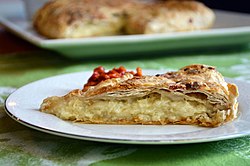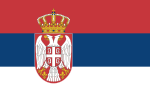Gibanica
 A piece of Gibanica. | |
| Alternative names | Gužvara (Crumpled pie) Serbian cheese pie[1][2] |
|---|---|
| Type | Pastry |
| Place of origin | Serbia |
| Region or state | Balkans |
| Serving temperature | Hot or cold |
| Main ingredients | phyllo dough, white cheese (feta, sirene), eggs |
| Other information | Other ingredients include milk, kaymak and lard or sunflower oil |
Gibanica (Serbian Cyrillic: Гибаница, [ˈɡibanit͡sa]) is a traditional pastry dish from Serbia popular all over the Balkans. It is usually made with white cheese and eggs. Recipes can range from sweet to savoury, and from simple to festive and elaborate multi-layered cakes.
A derivative of the verb gibati, meaning "to fold; sway, swing, rock", the pastry was mentioned in Serbian linguist Vuk Stefanović Karadžić's Serbian Dictionary (1818). It is traditionally served for breakfast with kefir or plain yogurt. Other than in the Balkans, Gibanica can be found worldwide in restaurants serving Serbian cuisine. It is one of the most popular and recognizable pastry dishes from the Balkans, whether served on festive occasions, or as a comforting family snack. In Serbia, the dish is eaten as breakfast, dinner, appetizer and snack, and often consumed at traditional events such as Christmas, Easter and Slava.
Etymology
In the vocabulary of the Yugoslav Academy, as well as in the etymological dictionary of Slavic languages, the word gibanica is a derivative of the Serbian verb gíbati/ (ги́бати), which means "to fold; sway, swing, rock". There are also derivatives like the word gibaničar (гибаничар) – one who makes gibanica, one who loves to eat gibanica, and one who always imposes as a guest and at someone else's expense.[3]
The word gibanica was first mentioned in the Balkans in the 17th century as a last name, or nickname. The Serbian word gibanica (гибаница) was included in the Serbian Dictionary compiled in 1818 by Serbian philologist-linguist and compiler-publisher of folkloric poetry Vuk Stefanović Karadžić (1787–1864). Karadžić traveled widely in the Balkans and recorded interesting facts relating to Serbian tradition and customs. He explained that gibanica "is a pie with soft cheese between the dough mixed with kaymak, milk and eggs."[3]
History
The pastry was first mentioned by Vuk Karadžić in 1818.[3] In Serbian cook Sofija Maksimović's book published in 1913, 17 variants of Gibanica were included; from ordinary with cheese, to those with poppy, cabbage, cherries or pumpkin, and even noodles or grits.[4]
During the Second World War, while hiding from Nazi German forces in the forests of Yugoslavia, Serbian Chetniks made the so-called Chetnik Gibanica from ingredients that they had received from peasants. When the commander of the Yugoslav Partisans, Josip Broz Tito, and Chetnik leader Draža Mihailović met at Ravna Gora in 1941, Gibanica and potato under sač with kaymak were served specifically for them.[5]
In 2007, the Gibanica officially became an export brand of Serbia. At the Brand Fair in Belgrade, the food industry "Alexandria" presented a half-baked and frozen gibanica for the international market.[6]
In the competitive cooking show Prvi kuvar Srbije (Best Cook of Serbia), the competitors are tasked with making traditional Serbian Proja and Gibanica.[7]
It was reported in 2016 that the ingredients used by Belgrade bakeries had switched to favour phyllo of buckwheat rather than the ordinary white flour. This is a result of healthy diet recommendations.[8]
Preparation
The original recipe for Gibanica included traditionally homemade phyllo dough and cow's milk cheese. Homemade cheese can be feta or sirene. The pie is usually made as gužvara (crumpled pie), so the phyllo dough in the middle is crumpled and filled. Besides cheese, the fill contains eggs, milk, kaymak, lard, salt and water. Also, stuffing may include spinach, meat, nettle, potato and onion. In order to speed up preparation, phyllo dough from a store can be used and sunflower oil or olive oil can be used instead of lard.[9]
Gibanica is a round-shaped pastry with crispy golden-brown crust. The inside is multi-layered, and includes crumpled dough with small pieces of cheese between each layer. Gibanica can be served hot in the morning and is commonly accompanied by yogurt.[9]
Variants

Many varieties of Gibanica and related dishes can be found throughout the Balkans; different gibanica are known as part of the national cuisines of Bosnia and Herzegovina, Croatia, the Republic of Macedonia, Serbia, Slovenia, and Friuli-Venezia Giulia (Italy, where it is called ghibanizza[10]), Greece, and Bulgaria, where it is usually called Banitsa.[3] Recipes can range from sweet to savoury, and from simple to festive and elaborate multi-layered cakes.[9] The so-called "Chetnik Gibanica" is the fatter, greasier version; it received the name after World War II.[11]
From the basic recipe, many local specialties have evolved. Prekmurska gibanica, for example, is a "fancy" multi-layered cake from Prekmurje in Slovenia, served as a dessert course on festive occasions.[12] Međimurska gibanica, from the neighbouring Međimurje region of Croatia, is a closely related but simpler and less "formal" dish consisting of four layers of fillings (prepared fresh cheese (quark), poppyseed, apple and walnut).[13] Another gibanica variety, called Prleška gibanica, is known from Prlekija to the west of the Mur River.[14]
The basic concept of Gibanica, a cake or pie involving a combination of pastry with cheese in differentiated layers often combined with layers of various other fillings, is common in the cuisines of the Balkans, Anatolia, and the Eastern Mediterranean. For example, a similar dish known as Shabiyat (Sh'abiyat, Shaabiyat) is part of the cuisine of Syria and Lebanon.[15] Gibanica can also be considered to resemble a type of cheese strudel, with which it likely shares a common ancestry in the pastry dishes of the region, and the cuisines of the Byzantine and Ottoman empires.
In culture
"If I had the cheese and the butter, my mother would know how to make Gibanica."
Gibanica is one of the most popular and recognizable pastry dishes from the Balkans, whether served on festive occasions, or as a comforting family snack. In Serbia, the dish is eaten as breakfast, dinner, appetizer and snack,[8] and is often consumed at traditional events such as Christmas, Easter and Slava.[9] According to the Serbian media, the largest Gibanica ever made was in the town of Mionica in 2007. It weighed over 1,000 kg, and was applied for inclusion in the Guinness Book of Records. 330 kg of phyllo dough, 330 kg of cheese, 3,300 eggs, 30 l. of oil, 110 l. of mineral water, 50 kg of lard and 500 packets of baking powder went into its creation.[16][17] In Serbia, as well as in neighboring countries, there are festivals dedicated to pies. One of them, called the Gibanica festival or Days of Banitsa, is held each year in Bela Palanka. It first took place in 2005.[18]
Other than in the Balkans, Gibanica can be found worldwide in restaurants serving Serbian cuisine.[19]
In the novel Pop Ćira i pop Spira (1894) by Serbian writer Stevan Sremac, in which the story surrounds two priests of different character in a Vojvodina village who compete over a newly arrived teacher who they want to marry with their daughters. Priest Ćira eats traditional dishes, including Gibanica, unlike Spira, who has turned to modern trends.[20]
Nutritional information
| Nutritional value per 100 g (3.5 oz) | |||||
|---|---|---|---|---|---|
| Energy | 1,255 kJ (300 kcal) | ||||
15.4 g | |||||
22.2 g | |||||
9.9 g | |||||
| |||||
See also
References
- ^ David Tornquist (1966). Look East, Look West: The Socialist Adventure in Yugoslavia. MacMillan. p. 229.
- ^ Brick. Applegarth Follies. 1991. p. 124.
- ^ a b c d e Republika 2003.
- ^ "Sve srpske kašike". NIN. 2000-12-28.
- ^ "AL' JE TITO DOBRO JEO, BAŠ!" (in Serbian). kurir-info.rs. Retrieved 23 March 2013.
- ^ "Srpska gibanica kao brend kompanije "Aleksandija"" (in Serbian). ekapija.com. Retrieved 26 March 2013.
- ^ "Prvi kuvar Srbije: Aleksandra Bursać pobedila u pravljenju proje!". Svet.
- ^ a b Telegraf 2016.
- ^ a b c d Serbia.com 2012.
- ^ Bonetti, Marzia; Fabbro, Claudio; Filiputti, Walter (2000). Enovagando: Friuli-Venezia Giulia : economia, turismo e cultura. Gorizia: Digi Press. p. 89.
- ^ "Recept za najbolju gibanicu". bastabalkana.com.
- ^ "Prekmurska gibanica". slovenia.info. Retrieved 21 March 2013.
- ^ "Međimurska gibanica" (in Croatian). medjimurski-dvori.hr. Archived from the original on 24 April 2012. Retrieved 21 March 2013.
{{cite news}}: Unknown parameter|dead-url=ignored (|url-status=suggested) (help) - ^ "Prleška gibanica". slovenia.info. Retrieved 21 March 2013.
- ^ "Shaabiyat". justapinch.com. Retrieved 21 March 2013.
- ^ "Gibanica teška tonu - Mioničani konkurišu za ulazak u Ginisovu knjigu rekorda" (in Serbian). ekapija.com. Retrieved 22 March 2013.
- ^ "Mionička gibanica za Ginisa" (in Serbian). politika.rs. Retrieved 22 March 2013.
- ^ "Takmičenje u pripremanju pita DANI BANICE" (in Serbian). manifestacije.com. Retrieved 23 March 2013.
- ^ "Gibanica i prebranac na Menhetnu - Amerikanci oduševljeni srpskim specijalitetim" (in Serbian). eKapija. 20 July 2008. Retrieved 22 March 2013.
- ^ "Stevan Sremac - Pop Ćira i pop Spira lektira". Lektire.
- ^ "Gibanica" (in Serbian). keepitfit.net. Archived from the original on 4 March 2016. Retrieved 23 March 2013.
{{cite news}}: Unknown parameter|deadurl=ignored (|url-status=suggested) (help)
Sources
- Zirojević, Olga (1–30 April 2003). "Gibanica". Republika (in Serbian). Vol. XV, no. 306–307. Republika. Retrieved 21 March 2013.
- "Gibanica, a pie like no other". Serbia.com. 4 December 2012. Retrieved 21 March 2013.
External links
- Dragas, Konstantin. "How To Make a Delicious Gibanica". Global Storybook.
- Folek, Barbara (29 May 2017). "Salty Serbian Gibanica Recipe #2". the spruce.
- "Gibanica više nikada neće biti ista! A svi su mislili da ovaj trenutak nikad neće doći". Telegraf. 22 November 2016.

